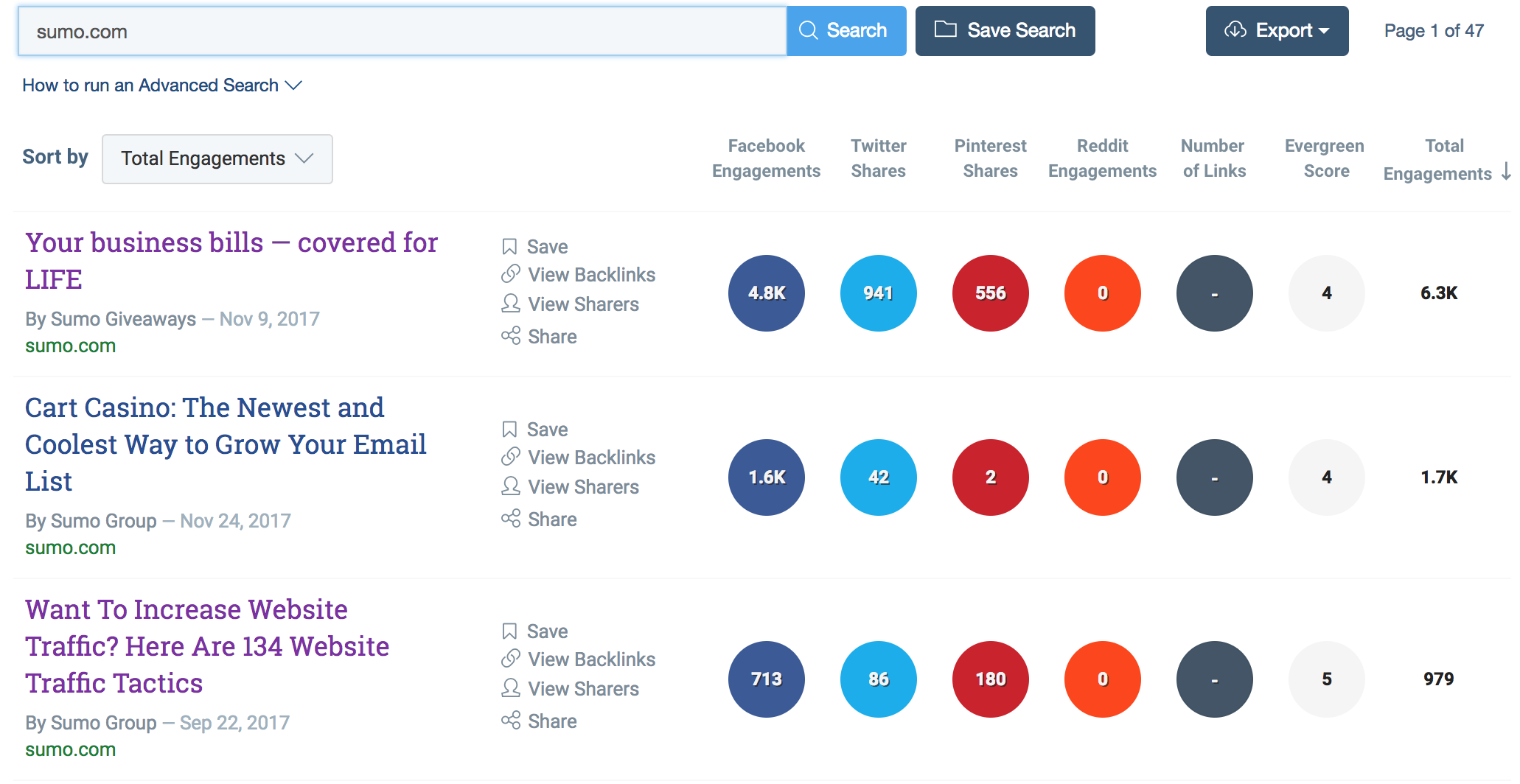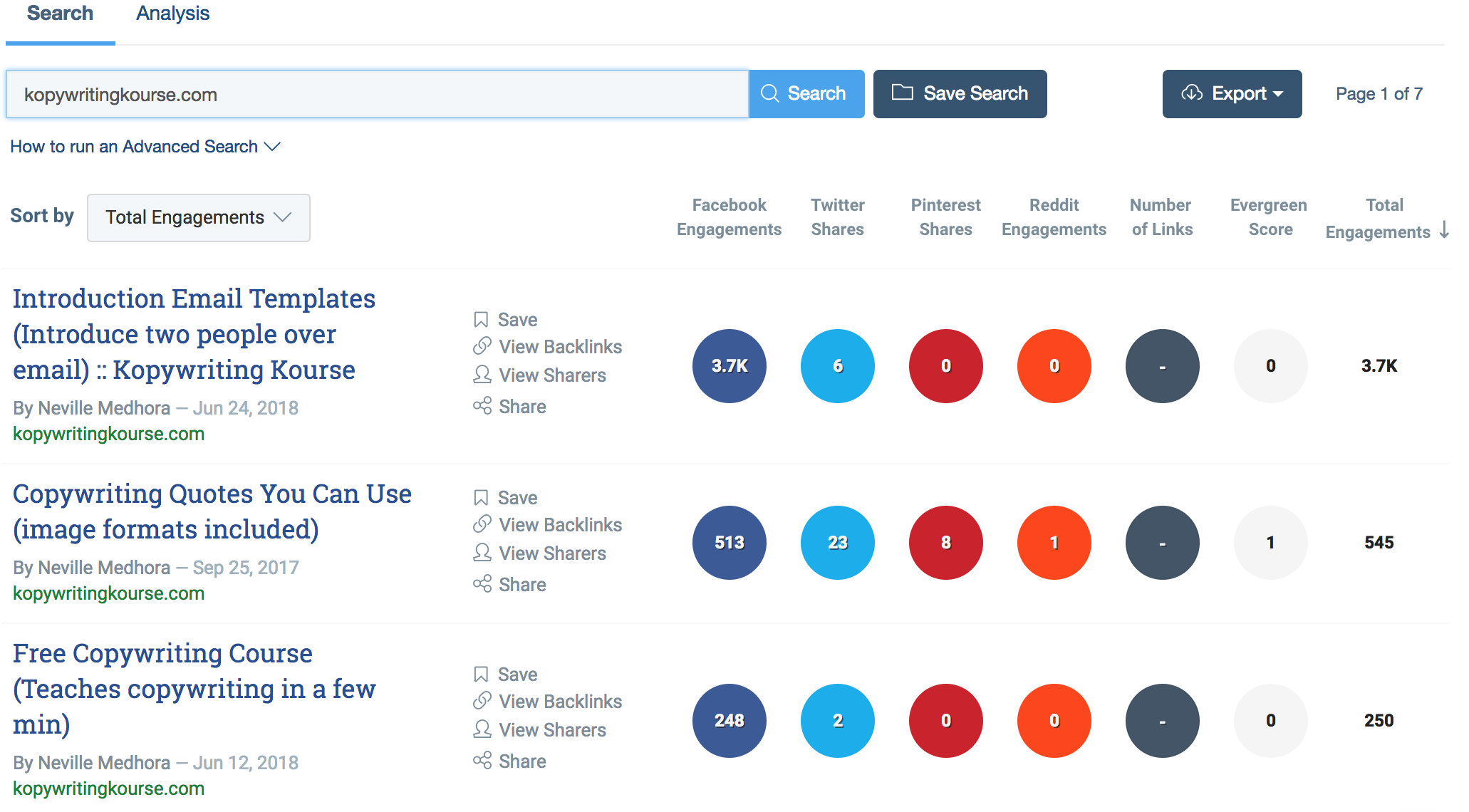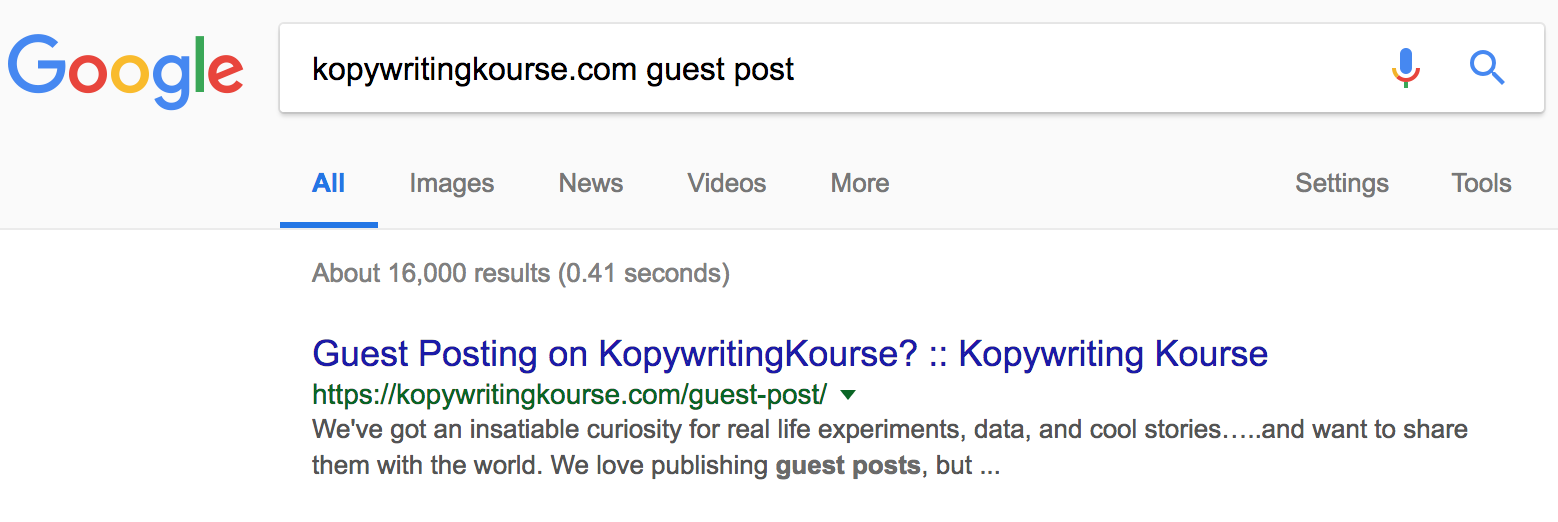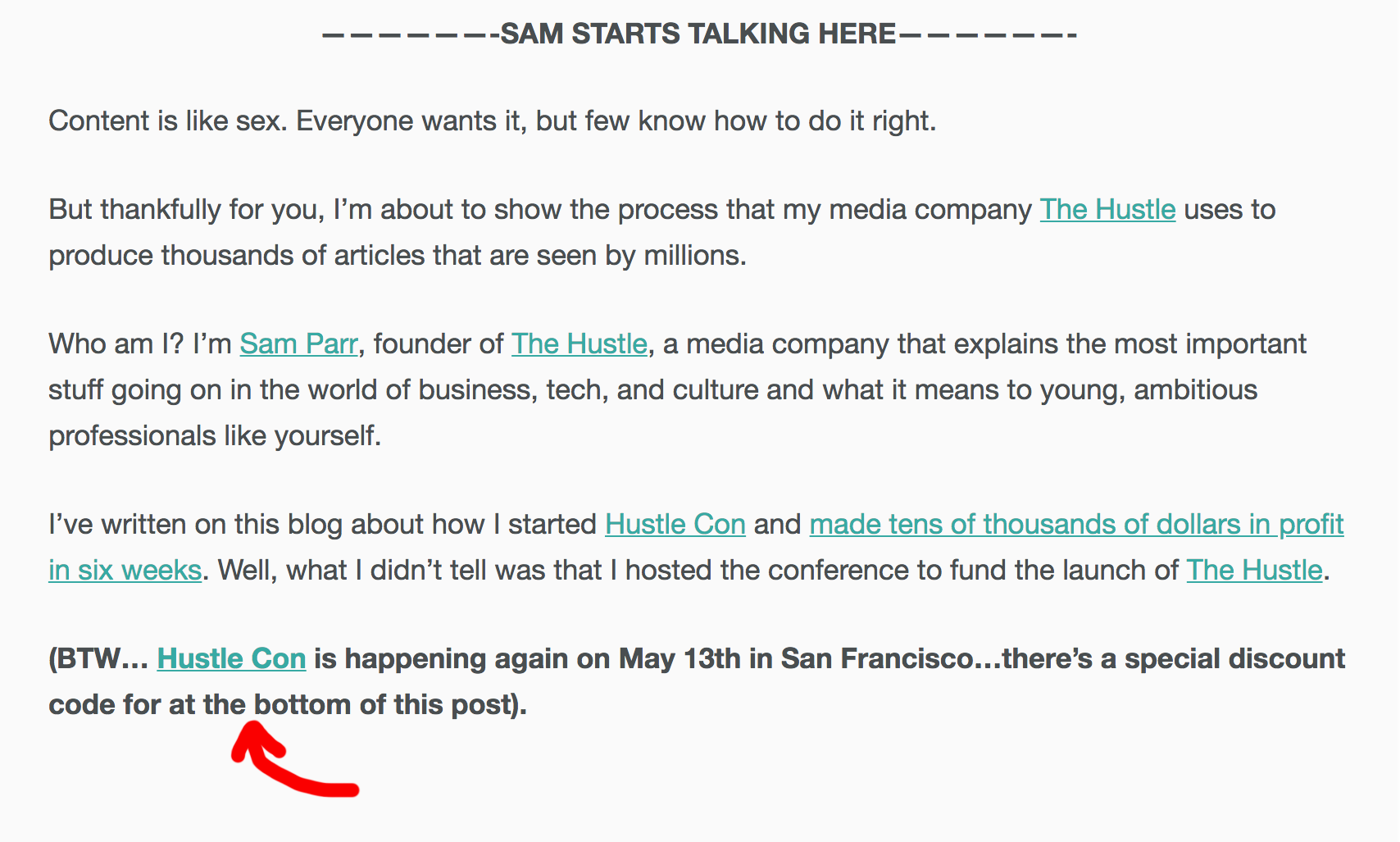What if I told you that there’s a way of growing your email list by the hundreds every month?
Instead of incrementally increasing your traffic, this one list building strategy can not only help you reach audiences you wouldn’t otherwise have access to, but a reach massive number of them?
It’s true.
This strategy is the one:
John Gannon used to add 1,800 email subscribers in one shot
Jon Morrow used to grow his blog to a multi-million dollar company
I used to grow Unsettle to it’s first 5,000 subscribers and beyond in under a year.
So what’s the one strategy?
Okay, the headline gave it away. The one strategy is guest blogging.
See, every content marketer, company, and blogger has a scarcity issue: the scarcity of great content, and the scarcity of time to create it.
It takes Sean & I anywhere from 20-40 hours to write one piece of content for Sumo. And that’s not even including the editing, publishing, and promotion of the content.
And content marketing drives a cubic ton of sales for the company. And I’m only exaggerating a little.
Amazing content is so valuable to us that if I get a really solid blog pitch, I snap it up faster than the interwebz snapped up these Joe Biden memes after the election.
Oh, and we have somewhere close to 700,000 email subscribers. So not only would that smart guest blogger get in front of a huge number of those subscribers, but also:
Rake in some strong Sumo backlink juice
Bask in the fame and glory of having published on one of the largest SAAS blogs in the marketing space, and
Collect leads, clients, and traffic. Did I mention glory?
With my very first guest post I was able to collect 800 new subscribers from my post on Fast Company (in just under 5 hours of work), and my guest post on Smart Blogger is still collecting emails...and it was published a year and a half ago.
In this guide, I’m going to walk you through the step by step process I (and many others) have used to grow my list rapidly with guest posting.
Not only have I grown my list this way, but I’ve also vetted a ton of guest post pitches as the primary contributions editor for Sumo’s blog. I’ll share with you the process I use as an editor to vet our guest post pitches, and the process as a blogger to pitch properly.
And if you want to save yourself time? Grab this FREE spreadsheet with 46 of the top websites that accept guest posts, contribution guidelines, and editor contacts.
Click here to get the FREE spreadsheet
Let’s get into it.
Step 1: Identify Strong Targets for Your Content
This is probably no surprise to you, but I have to say it anyway:
If you choose the wrong publications to guest post on, you can kiss those potential email subscribers goodbye.
This strategy only works if you are aiming at the right publications. And chances are, you have a few ideas of websites you’d like to guest post on already.
These are likely popular websites within your industry or niche that seem like good sites to write for.
But before you charge forward to the next step assuming you’ve already figured this all out, spend some time on this step to make sure the websites are actually good guest posting targets.
A good guest posting target website hits all of these criteria:
The website reaches a large number of people within your target audience. There’s no good way to find out traffic numbers or email subscribers on your target blogs, but a quick search of BuzzSumo should show you share numbers:
If the blog has articles at least a couple hundred shares, this is good news. The more the merrier, but some strong targets don’t attract a huge number of shares.The website accepts guest blogging. Duh. You can tell whether they’ll even accept your pitch by searching for contributor guidelines or checking to see if there are other guest posts on the site.
Google search the url + “guest post”, “contributor” or “writer guidelines”.The website allows a call to action (such as a content upgrade) within the submitted article or in your author bio. You can usually tell by checking to see whether other author bios have links in them.
The website follows the post immediately with the author bio. Your guest post won’t benefit you if the publication buries your credit.
There are 3 main types of websites that accept guest posts.
Large Media Publications: Websites like Huffington Post, Entrepreneur, Slate, Alternet, Babble, MSN Money, and others. These websites are media companies that usually publish a very high volume of content about a wide range of topics within the industry. These reach the largest audience of the three types of websites, but it can be more difficult to stand out.
Personal Brands: Personal brands and blogs (even ones that have turned into larger publishing companies), such as Smart Passive Income, Scary Mommy, Pinch of Yum, and Nerd Fitness, often accept guest posts. These can be some of the best publications to guest post on, because their audiences tend to be relatively large and far more engaged than media publications.
Company Websites: The third type of publication for guest posting is on company website blogs. Not every company has a blog, but the ones that do can attract a huge, engaged audience. Sumo’s blog is a company blog, as is Buffer.
There’s some opinion that personal blogs are the most effective place to guest post, and that can be true, but I’ve seen 800 email subscribers from one article on Fast Company and 1,100 from just one on Elite Daily (both media publications).
Yet some of the most gigantic personal brands I’ve written for have netted me under 100 subscribers.
I’m not saying personal blogs are bad targets. I’m arguing that the key isn’t in which publication you write on, it’s about what you write about, how well you write about it, and how you capture those emails.
Lucky for you, you’ll have mastered all of these elements by the end of this guide. Keep going!
Step 2: Choose An Amazing Topic
When doing their guest post research a lot of people think of something they want to write about that would serve them, and then try to find a publication or blog that would accept the topic.
This is all wrong.
Each publication has it’s own voice, and the audience expects specific topics and angles from them.
Instead of trying to fit the publication into your mold, let the publication (and what’s popular on it) mold what you write about.
You can reverse engineer a super popular guest post on your publications of choice just by doing the right research.
That way, you’ll never fail.
To do this, find what has already worked (the top content on the publication) and simply do more of that. After all, there’s a reason those articles are popular. Let’s look at Sumo for an example.
Using BuzzSumo...

I found that the most popular content on the Sumo blog (that wasn't a giveaway) was:
These guides are popular because they are step-by-step, they go deep on a particular topic, and they help the reader achieve a result. This resonates most with our audience.
My point is, when you’re choosing a topic for any piece of content, look for patterns within existing popular content.
Using our Sumo example, there are definite patterns in the popular guides:
They’re all about increasing traffic, conversions, or revenue
They’re specific to growing your website
They dig deep on a specific topic (power words, growing traffic, republishing, headlines)
They use marketing principles that are *gasp* backed by research, experimentation, and results.
Finding the patterns in your target publication should help you brainstorm a few topics that are bound to do well. After all, the point here is not to just get any old post up on these publications.
This strategy will only work if the articles you’re submitting are popular articles full of information or stories that their audience (your target audience) wants to read.
This can be done on websites that aren’t Sumo, too.
But you don’t want to choose a topic that’s only beneficial for the host blog. Remember, your guest post needs to also drive an engaged portion of your target market to your landing page to get your content upgrade. That’s how you build your list with guest posting.
So, instead of just thinking in terms of what will be popular on the target blog, think of a topic that will be popular on the blog that would also attract your target audience and overlap with your own blog topic.
As long as your topics fall within the overlapping area of the Venn diagram, you’re good to go.
Also, don’t stop at just one topic. When you get to the fourth step, which is pitching your topics to the blog editor, you can’t put all your eggs in one basket. You need to pitch them at least 3 different topics to choose from.
When I pitch, the topic the editor chooses is almost always the initial topic I came up with. But I want to provide them with choice in case they’ve already identified that content opportunity for their blog or have something similar in the works - or maybe just even don’t like the topic.
Protip: Before you move onto the next step, make sure the topic hasn’t already been published on the blog you’re interested in posting on. A variation of the topic is usually okay if you can take it from a different angle.
I did this with my Fast Company guest post - I saw a lot of posts about why you should wake up early, but not how to wake up early. Just don’t pitch a me-too topic.
Even if you include one repeat topic in a list of four potential topics, it shows the editor you didn’t do your homework.
Step 3: Write Dazzling Headlines That Capture Attention
You might think your work here is done, right? You can just move onto the pitch email, get accepted, and start writing.
But you should know better than that by now.
After all, I’ve harped over and over again about how important headlines are. And they’re not just important for the finished product of your articles. Nope, they’re important for your pitches, too.
A strong headline is the only reason my Fast Company guest post got accepted.
The email was long and unwieldy, and my pitch was sort of desperate, but what editor could overlook an impressive headline?
If your headlines suck, no matter how good the email was, the pitch will be rejected (or, most likely, ignored).
Don’t make the blogger or editor read between the lines. You shouldn’t have to explain your topic - the headline should do the heavy lifting.
Protip: Use Sumo’s Headline Generator to find a bunch of awesome variations of headlines.
Once you’ve come up with some solid headlines for your pitch, you can move onto the next step.
Step 4: Send a Pitch Email That Actually Gets Read
The next step in the guest posting process is to pitch the topic ideas that you came up with in the last step to the blogger or editor.
This is probably the easiest step, but it’s definitely the one that most people find the most daunting.
But don’t worry. If you did the work I’ve outlined in this guide and followed my instructions, you’re highly unlikely to be rejected.
Here is a list of all the information you should be including in your pitch email:
Your Subject Line:Editors and bloggers get tons of pitch emails. If your subject line sucks, your email won’t get opened. I find “Quick question” “Hey [name] - quick question”, “Question for today”, or some variation of that to be the most effective.
The First Couple of Lines: Do not call the editor by the wrong name. I repeat… do NOT call the editor by the wrong name. That means that if you absolutely must copy and paste, double check, then proof-read, then re-read. Then, for good measure. Check again.
Include something personal if you can - this especially applies to personal blogs. You shouldn't be pitching the blog if you haven’t done your research, so this should be simple.
The Why: Go the extra mile to show you’ve actually done the research. Very quickly explain why you’re pitching the topics you did.
The Pitch: Pitch at least three different topics. List alternative headlines under each, and if there is any ambiguity, a couple of sentences to share how you’d tackle the topic.
Social Proof: If you can, show some social proof. This means writing samples from other large publications. If you’ve never been published anywhere other than your own blog, that’s fine. Choose your most popular posts from your blog and use those as samples.
Of course, if the contributor’s guidelines outline a different process, scrap all of this and follow their process. I’m not the editor of every blog out there.
Maybe they want you to submit a finished draft. In which case, choose the topic that you think will be most popular on the blog, write the shit out of the thing, and submit it directly.
But I’d say 80% of blogs either expect this type of pitching process or don’t have guidelines at all.
Oh, and guys? Don’t make the biggest pitching faux pas possible and write the editor a novel.
Keep pitch emails short and to the point. Influencers, editors, and content marketers are busy. They won’t read your life story.
Protip: Try to send the pitch email directly to the editor. Contact form responses are not read at the same rate as regular emails.
If you can’t find the contact information for the editor on the website, you can usually try the format: firstname@siteurl.com (ex: sarah@unsettle.org) to reach the editor.
Step 5: Write an Amazingly Useful Article
So let’s assume that you followed this process to a tee. Because then we can assume you have a successful pitch and the editor has told you to go ahead and write one of your ideas.
Congratulations! Now’s the fun (read: hard) part.
An accepted pitch is just that -- an accepted pitch. If you turn around and submit a shitty article, the editor is going to reject it, making all of the work you’ve done up until this point moot.
So to make sure this doesn’t happen, write the best damn article you’ve ever written. The content you’re sending to the editor needs to be so good that they can’t not publish it.
While you’re writing it, you need to have their most popular posts open, so you can make sure your post fits right into their blog. Match the blog’s:
Tone and Personality. Look, I know you have your own personality. And your readers probably eat it up. But readers of the host blog have come to expect a certain tone from that blog, and if you don’t match it, your post will be rejected or flop. On Sumo, we’re sarcastic, use memes and gifs, and have a lot of personality. The first drafts that get my attention are the ones that follow suit.
Style. It doesn’t matter if it rubs you the wrong way -- if the host blog publishes textbook style blocks of text when you’re used to writing 2-3 sentence paragraphs, you’d better smash those sentences together, baby. At Sumo, we bold things. We italicize things. And bulleted lists are our friends. If I’m hit with an article written like a textbook, that pitch is getting rejected.
Structure. Does every post on the host blog have an intro, a body, and a conclusion before launching into the CTA? Yours shall, too. Are the posts 500-1000 words like Entrepreneur.com or 3,000-5,000 like Sumo? Follow suit.
Here’s the important thing: do not make the editor make these changes for you.
If there are too many of these types of changes to make, your article will be rejected. If you’re pitching to Sumo and you:
Say popup instead of pop-up
Use huge, chunky paragraphs
Try to send me a 1000 word post trying to front as an “ultimate guide”
And your post has no text styling, bye-bye pitch email.
If you really nail the guest post, not only will this ensure you collect the most subscribers, but the blog owner will appreciate the great content - causing them to actually promote it, work hard to get the word out there, and potentially even invite you back to guest post again.
Not to mention that writing even one amazing guest post for a large, popular publication helps you build social proof.
You never know what type of opportunities can come from a well-written article on the right publication. I got my position with Sumo because our CEO, Noah Kagan, noticed one of my articles on Smart Blogger and reached out.
Guest posting is content marketing - it establishes authority, which can lead to more sales, exposure, and inter-fame than you’ll know what to do with.
You just have to do it right.
Protip: Use the opportunity of the guest post to include 1-2 backlinks to strong pieces of content you want to rank for.
Step 6: Create a Spellbinding Content Upgrade
It’s your worst nightmare.
You find the perfect guest posting target blog. You brainstorm a few topics that will both attract your target audience and please the target blog’s readers. You have an accepted pitch, wrote an amazing post, and it’s publish day…
Yet you only get 10 subscribers from that article you worked so hard on.
If you did everything right until this point, guess what? This can still happen. And the culprit?
Your content upgrade.
This is the most important part of the guest posting puzzle if you want to grow your list and get the most utility from your articles.
Guest posts take far longer than in-house content to write. You have to craft the pitch, do the research, and make the article insanely perfect. You want to make sure that actually pays dividends and works for you.
If you sink 20 hours into researching, pitching, and writing a guest post, you need to have the best damn content upgrade out there.
I see so many people hustle on guest posts but fail on their content upgrades. So let me be clear:
If you don’t create an amazing content upgrade for your guest blog, you’re literally kissing your time, effort, and hundreds (if not thousands) of potential email subscribers bye-bye.
The content upgrade on my guide to Instagram marketing collected 7,500 emails between the Click Trigger and Welcome Mat.
But we’ve also had content upgrades that have flopped, too - to the tune of fewer than 40 email subscribers for articles we’ve emailed our list about.
So how can you find the perfect content upgrade for your guest post?
Ask yourself these three questions:
What resources would the reader need to get the most utility from this article?
What would make it much easier for the reader to act upon the article?
What freebie can I give away that’s so enticing they can’t say no?
From our analysis of the content upgrades offered on Sumo, we find swipe files and spreadsheets to work really well. However, that’s what our audience responds to.
What will yours respond to?
For my content upgrade on my Smart Blogger article, I offered a guide to finding a product idea for bloggers.
I’d just told the Smart Blogger audience that monetizing through ads was a silly idea. I then gave them a bunch of alternatives to that, including creating your own product (which I happen to know, for most bloggers, is the most appealing option).
I anticipated the next question in the reader’s mind would be: “Okay, but how do I know which product to create?”
So I solved that problem in my content upgrade, which has brought in over 530 email subscribers.
Whatever you do, don’t overlook the content upgrade. This is the one thing that will help your guest post not just be popular and read-worthy, but pay you dividends in terms of email subscribers.
And since your email list is your ATM, you can’t slip up on this.
Protip: I repurposed a content upgrade I had previously used in another guest post for this one. You can’t always do that - sometimes, it’s not such a natural and obvious fit - but if you write about similar topics, this can save you time.
Step 7: Craft a Compelling Call to Action
You can create the best content upgrade in the world, but if you don’t sell that content upgrade in your call to action, it will flop.
For most guest posts, you can only place one call to action to get your content upgrade, and that’s in your bio.
Some host websites will allow you to include more than one call to action. But this is fairly rare.
You can either ask the host blogger or try to put another CTA where it fits seamlessly if you want to take advantage of this opportunity (which will, admittedly, convert many more people).
Since calls to action are short, to the point and very important, make sure you isolate your CTA.
That means only putting one link in your bio - and that should be to your content upgrade landing page (not your website, social media profiles, or other content).
Your bio will typically have one sentence about you (maximum two), and a one sentence call to action.
Isolate your call to action. Use power words. And do what you can to make the CTA as enticing as humanly possible. This means paying attention to the headline of your content upgrade and how you “sell” it.
Protip: Just because you get readers from the post to your landing page through your call to action doesn’t mean you have it in the bag. Bring that CTA goodness over to the landing page that you’re sending your traffic to.
Stop Letting Your Content Flop
If your guest posts add fewer than 100 email subscribers to your list, they’re not working hard enough for you.
If you are guest posting only for backlinks, they’re not working hard enough for you.
And if you’ve ever had a rejected guest post pitch, you probably could have turned it around.
So stop letting those guest posts flop, and start collecting massive amounts of emails and social proof.
Start by finding the best guest posting targets possible. Then, find your perfect topic ideas, send the pitch email, and get writing. And most importantly, don’t forget that content upgrade.
And if you want to save yourself time? Grab this FREE spreadsheet with websites that accept guest posts, contribution guidelines, and editor contacts.
Click here to get the FREE spreadsheet
Oh, and also? This process can be used for more than just guest posts. If you want to write solid content on your own blog, you can increase your opt-ins through your content upgrades through this process, too.





Comments